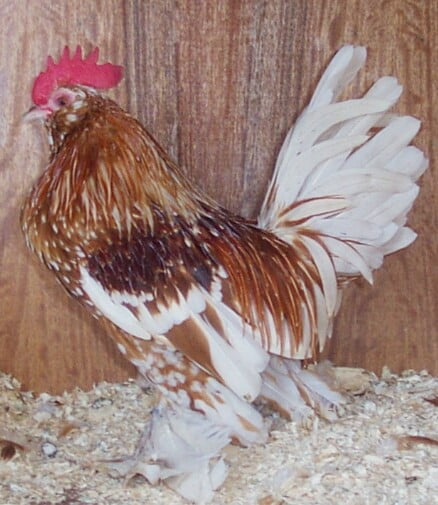The Belgian Bearded d’Uccle line is my favorite project since I am of Belgian descent. My birds have won Best of Breed and almost every Best of Variety in every show that I attended in 2001 in four different States. My line has illustrated a good ‘V’ topline, long foot feathers, beautiful beards and muffs with very small or non-existent wattles, and excellent color. Click on each photo to view the individual Variety pages.
The Belgian d’Uccle Bantam was bred for the first time in the small municipality of Uccle at the southeast border of Brussels, Belgium by Michel Van Gelder, sometime between 1890 and 1900. The ‘d’ in front of d’Uccle means from or of (Uccle). If you happen to be in Belgium, the ‘d’ is dropped, and they are simply referred to as ‘Uccles’. Most authors believe that the Belgian d’Uccle Bantam is a cross between the Dutch Booted Sabelpoot Bantam and the Antwerp Bearded Bantam, but this fact is not known for sure. Mr. Van Gelder traveled to many English and German poultry shows and the chance remains that some breeding material could have originated from either country. The Dutch Booted Sabelpoot Bantam actually originated from somewhere in Asia and is believed to contain some Japanese Bantam blood. So the d’Uccle has both Asian and Belgian roots.
The first varieties of Belgian d’Uccles were the Mille Fleur, Porcelain, and White, but the Mille Fleur was the first variety entered into the American Poultry Association’s Standards of Perfection in 1914. This was thirty-five years after the entrance of the Booted Bantam (a distinctly different breed from the Belgian d’Uccle). I mention this because sometimes the Booted Bantam and the Belgian d’Uccle are confused with one another.
I have attended poultry shows where a Booted Bantam has been entered as a Belgian d’Uccle (and at least one actually won the class). Under the standards, and as I understand it from the Belgian d’Uccle and Booted Bantam Club, these birds should have been disqualified as entered into the wrong class.
To the average fancier who does not breed or show Booteds or Belgian d’Uccles, the differences between the two may not be significant. But to a Belgian breeder of Belgian d’Uccles, and to the Belgian d’Uccle and Booted Bantam Club, the differences are very distinct. The most obvious difference is that the Booted Bantam has no beard or muffs, and has wattles instead. The Belgian d’Uccle has very small or non-existent wattles with a full beard and muffs. The feathered ‘muffs’ at each cheek help to create the pretty little face that is characteristic of the d’Uccle hen. The Belgian d’Uccle is also smaller than the Booted because it was bred, in part, from the Antwerp. The Belgian d’Uccle should be shorter with a broader breast and a ‘bull’ neck. The subtlest of the differences between the two breeds is in the topline. The Booted should have a longer back with a topline in the shape of a ‘U’, and the Belgian d’Uccle should have a topline in the shape of a ‘V’. Both breeds have a higher tail carriage than most other breeds and have feathered feet and well-developed vulture hocks.



